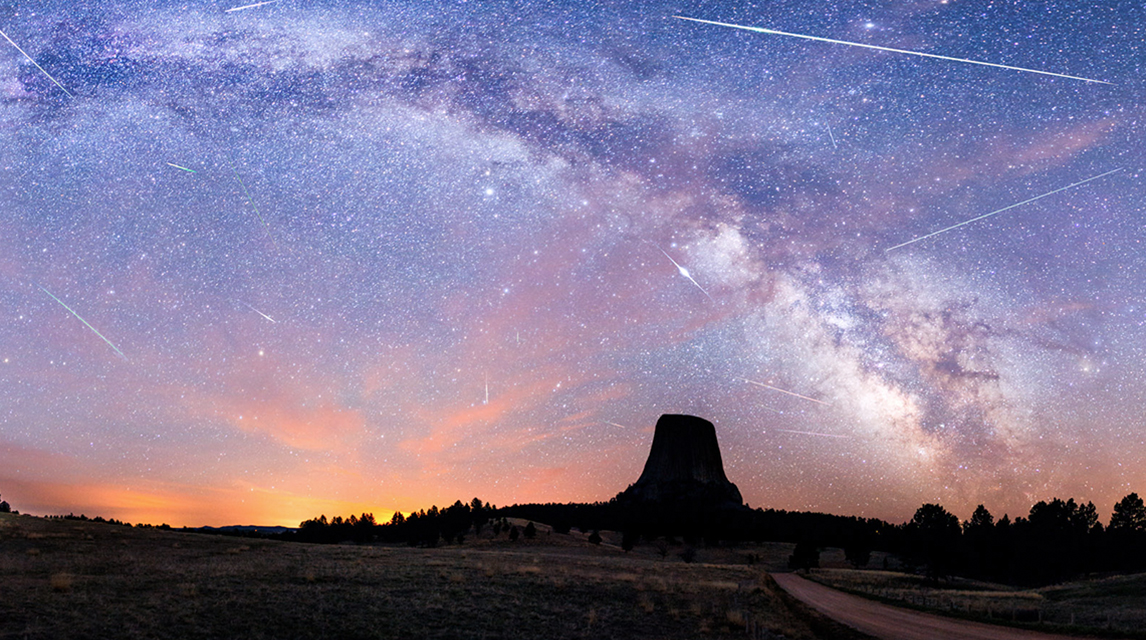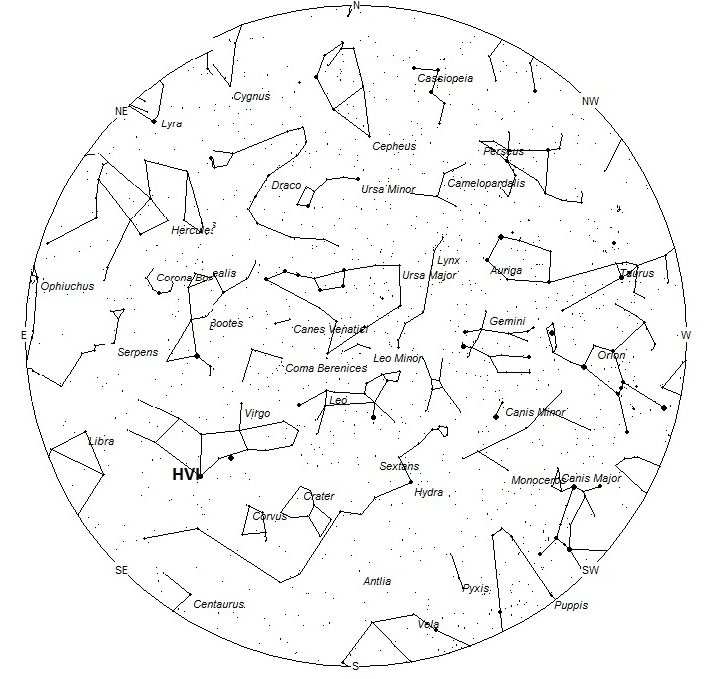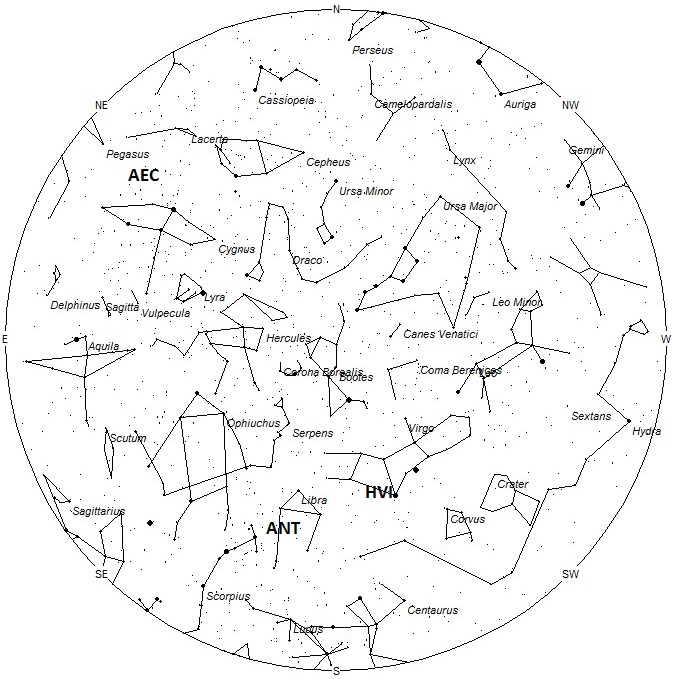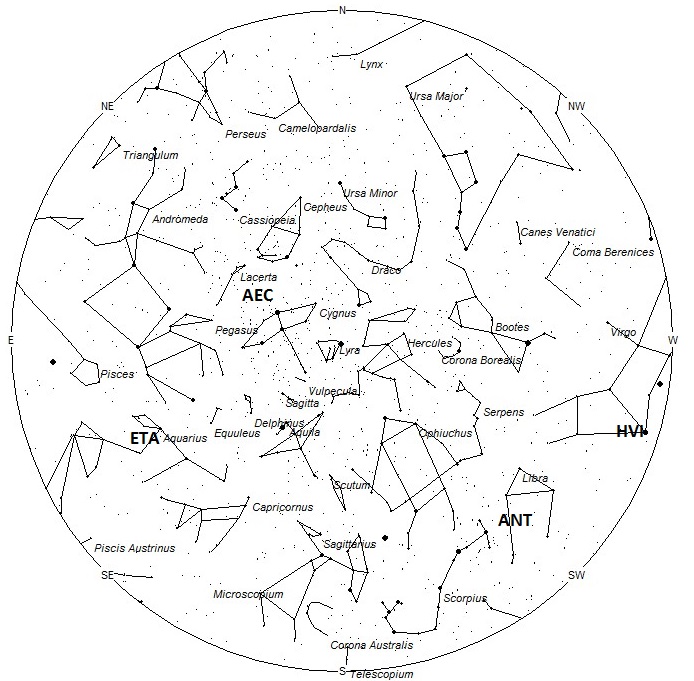
May is the best springtime month (in the northern hemisphere) to view meteor activity. The eta Aquariids are very active the first two weeks of the month then fade as the month progresses. These meteors are only visible in a few dark hours prior to dawn. The remainder of the night has low meteor rates. The only other showers of note this month are the eta Lyrids and the Anthelion radiant. These will add only 2-3 meteors per hour to the total count. Sporadic rates are low but steady as seen from the mid-northern hemisphere (45 N). Sporadic rates seen from the tropical southern latitudes (25 S) are strong and remain so the entire month.
During this period the moon reaches its first quarter phase on Tuesday May 2nd. At this time the half illuminated moon is located 90 degrees east of the sun and sets near 0200 local daylight saving time (LDST) as seen from mid-northern latitudes. This weekend the waxing crescent moon will interfere with meteor observations during the evening hours but will have set by the time midnight arrives. This will allow good meteor viewing conditions for the remainder of the night. The estimated total hourly meteor rates for evening observers this week is near 3 for those viewing from the northern hemisphere and 4 for those located south of the equator. For morning observers the estimated total hourly rates should be near 9 as seen from mid-northern latitudes (45N) and 14 as seen from tropical southern locations (25S). Evening rates are slightly reduced during this period due to lunar interference. The actual rates will also depend on factors such as personal light and motion perception, local weather conditions, alertness and experience in watching meteor activity. Note that the hourly rates listed below are estimates as viewed from dark sky sites away from urban light sources. Observers viewing from urban areas will see less activity as only the brightest meteors will be visible from such locations.
The radiant (the area of the sky where meteors appear to shoot from) positions and rates listed below are exact for Saturday night/Sunday morning April 29/30. These positions do not change greatly day to day so the listed coordinates may be used during this entire period. Most star atlases (available at science stores and planetariums) will provide maps with grid lines of the celestial coordinates so that you may find out exactly where these positions are located in the sky. A planisphere or computer planetarium program is also useful in showing the sky at any time of night on any date of the year. Activity from each radiant is best seen when it is positioned highest in the sky, either due north or south along the meridian, depending on your latitude. It must be remembered that meteor activity is rarely seen at the radiant position. Rather they shoot outwards from the radiant so it is best to center your field of view so that the radiant lies at the edge and not the center. Viewing there will allow you to easily trace the path of each meteor back to the radiant (if it is a shower member) or in another direction if it is a sporadic. Meteor activity is not seen from radiants that are located below the horizon. The positions below are listed in a west to east manner in order of right ascension (celestial longitude). The positions listed first are located further west therefore are accessible earlier in the night while those listed further down the list rise later in the night.
These sources of meteoric activity are expected to be active this week.
.
The h Virginids (HVI) were discovered by Japanese observers of SonotaCo using video data obtained in 2007 and 2008. These meteors are active from April 29-May 3 with maximum activity occurring on the May 1st. On May 1st, the radiant is located at 13:40 (205) -11. This area of the sky is located in southern Virgo, 2 degrees east of the 1st magnitude star known as Spica (alpha Virginis). This radiant is best placed near midnight LDST, when it lies highest above the horizon in a dark sky. Current rates are expected to be less than 1 per hour even at maximum. These meteors are seen equally well from both hemispheres. With an entry velocity of 17 km/sec., the average meteor from this source would be of slow velocity.
The center of the large Anthelion (ANT) radiant is currently located at 15:28 (232) -19. This position lies in eastern Libra, 5 degrees south of the 4th magnitude star known as Zuben-el-Akrab (gamma Librae). Due to the large size of this radiant, Anthelion activity may also appear from the nearby constellations of Serpens Caput, western Scorpius, and southern Ophiuchus as well as Libra. This radiant is best placed near 0200 local LDST, when it lies on the meridian and is located highest in the sky. Rates at this time should be near 2 per hour as seen from mid-northern latitudes (45 N) and 3 per hour as seen from the southern tropics (S 25) . With an entry velocity of 30 km/sec., the average Anthelion meteor would be of slow velocity.
The April rho Cygnids (AEC) were discovered by Dr. Peter Brown during his meteoroid stream survey using the Canadian Meteor Orbit Radar. These meteors are active from April 11-May 4 with maximum activity occurring on the 22nd. The radiant is currently located at 21:48 (327) +47. This area of the sky is located in eastern Cygnus some 10 degrees east of the 1st magnitude star known as Deneb (alpha Cygni). This radiant is best placed during the last hour before dawn when it lies highest above the horizon in a dark sky. Current rates are expected to be less than 1 per hour no matter your location. With an entry velocity of 42 km/sec., the average meteor from this source would be of medium velocity. Note that these meteors are synonymous with the Nu Cygnids (Molau and Rendtel, 2009).
The eta Aquariids (ETA) are particles from Halley’s Comet, produced in Earth-crossing orbits many centuries ago. We pass closest to these orbits from May 5 through the 9th. During this period the eta Aquariids are at their best, capable of producing zenith hourly rates (ZHRs) of 60. The actual visible rates are most often less than half this figure due to the low altitude of the radiant at dawn. Observed hourly rates at maximum normally vary from zero at 60 degrees north latitude to 30 near the equator and back down to near zero again in Antarctica, where the radiant elevation is again very low. Hourly rates this weekend will most likely be 2-3 per hour as seen from mid-northern latitudes. The radiant is currently located at 22:16 (334) -03. This area of the sky is located in northern Aquarius, 2 degrees southwest of the fourth magnitude star known as Sadalachbia (gamma Aquarii). The best time to view this activity is during the hour before the start of morning twilight, when the radiant lies highest in a dark sky. With the radiant low in the east it would be best to face halfway up in the sky in that same direction. If the radiant has sufficient altitude eta Aquariid meteors can also be seen shooting down toward the eastern horizon. With an entry velocity of 68 kilometers per second, a majority of these meteors will appear to move swiftly with a high percentage of the bright meteors leaving persistent trains. Surprisingly, this shower produces very few fireballs.
As seen from the mid-northern hemisphere (45N) one would expect to see approximately 5 sporadic meteors per hour during the last hour before dawn as seen from rural observing sites. Evening rates would be near 2 per hour. As seen from the tropical southern latitudes (25S), morning rates would be near 8 per hour as seen from rural observing sites and 3 per hour during the evening hours. Locations between these two extremes would see activity between the listed figures.
The list below offers the information from above in tabular form. Rates and positions are exact for Saturday night/Sunday morning except where noted in the shower descriptions.
| SHOWER | DATE OF MAXIMUM ACTIVITY | CELESTIAL POSITION | ENTRY VELOCITY | CULMINATION | HOURLY RATE | CLASS |
| RA (RA in Deg.) DEC | Km/Sec | Local Daylight Saving Time | North-South | |||
| H Virginids (HVI) | May 01 | 13:40 (205) -11 | 17 | 00:00 | <1 – <1 | IV |
| Anthelions (ANT) | – | 15:28 (232) -19 | 30 | 02:00 | 2 – 3 | II |
| April rho Cygnids (AEC) | Apr 22 | 21:48 (327) +47 | 42 | 08:00 | <1 – <1 | IV |
| eta Aquariids (ETA) | May 07 | 22:16 (334) -03 | 67 | 08:00 | 2 – 3 | I |
 American Meteor Society
American Meteor Society



My only comment is this. I’m 43 years old soon to be 44 . And today may 1 2017 @ approximately 5:30 am I saw my first shooting star ever. Ive never seen anything so honest or magnificent . I hope to see more beautiful thing like this before our time on this earth is through.